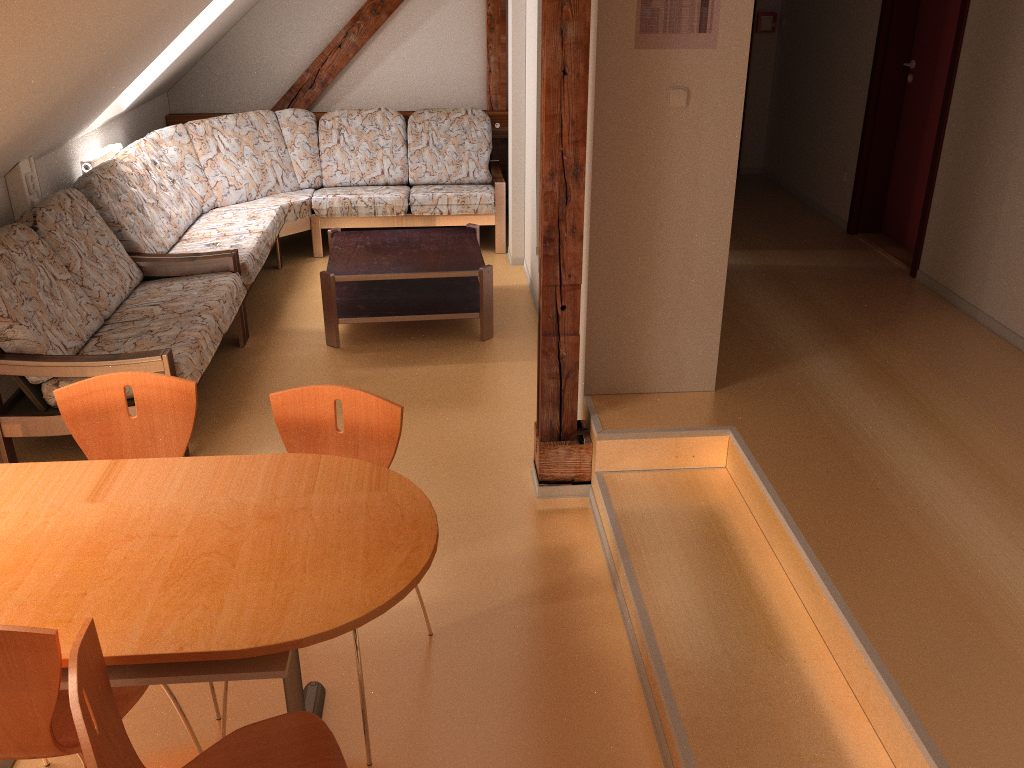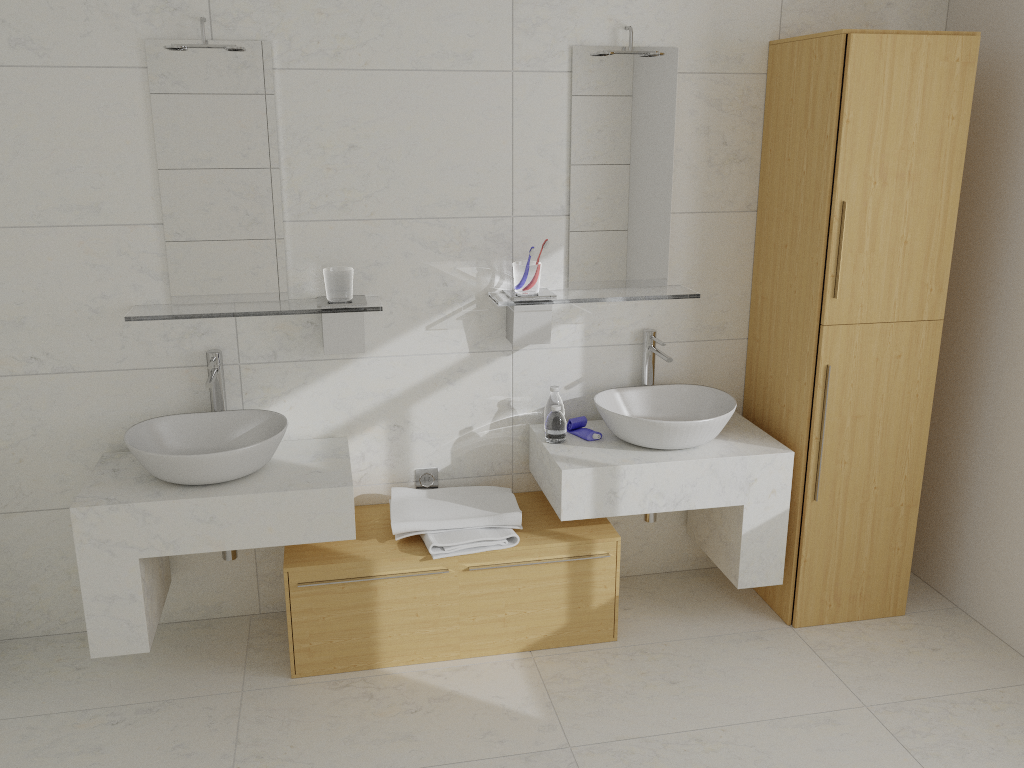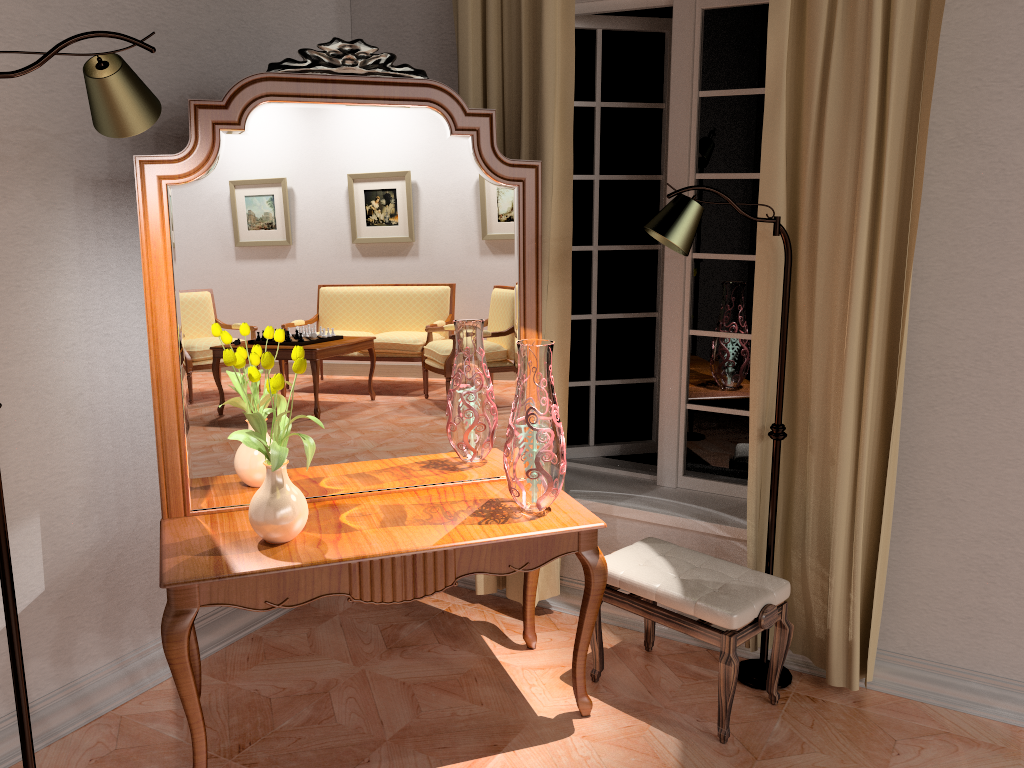- Česky (cs)
- English (en)
Global Illumination Rendering Toolkit
Global Illumination Rendering Toolkit (GIRT) is a software package allowing real-time previews as well as high quality rendering of scenes by using a number of global illumination algorithms. Particularly it supports path tracing, bidirectional path tracing, light tracing, photon mapping, and vertex connection and merging algorithm. Example images and videos created by GIRT as shown below. Further renders, videos, and data will be added soon.
Platform: Windows / Linux
Developers: Robin Hub, Martin Stys, Jiri Bittner
Source codes available for download.
Sample Images Rendered by GIRT
Bedroom
Image of a virtual bedroom generated by the Vertex connection and merging algorithm implementation within the GIRT library. The original scene was modeled by David Vacek to be used as a so called lighting challenge. CTU student, Martin Stys, took the original model, made some adjustments, and created all textures and materials. We used this scene to see how the library deals with the geometrically complex environments that are close to the production. The VCM algorithm was required due to the spoon in the teapot that is located on the table.
Light sources: All energy comes from two area light sources that represent windows. To simulate sun, both light sources have Phong emission profile so the largest amount of energy comes from the directions around sun light direction.
Materials: The scene contains diffuse, glossy as well as specular materials. More specifically, the Lambertian BSDF, Phong physically correct BSDF, mirror BSDF, and glass BSDF were used.
- Time: 18.3 [h]
- Resolution: 3840 x 2160
- Initial merging radius: 0.111293 [m]
- Number of iterations: 145
- Eye/Light paths count: 8 294 400 [per iteration]
- Average connections count: 199 065 600 [per iteration]
DCGI hallway
Image of the hallway at Department of computer graphics and interaction at Czech Technical University. The scene was created within the Bachelor thesis by Tomas Kraus. The lighting effects in this scene are relatively easy captured by common unbiased or consistent global illumination algorithms. Presented image was created using Vertex connection and merging algorithm but it could have been also generated by relatively simple Bidirectional path tracing.
Light sources: There is only a single light source in this scene and it used to simulate daylight of a cloudy day. More specifically there is a diffuse area light source that serves as a roof window. The surface of the light spans the entire hole generated by the window.
Materials: The scene contains diffuse, glossy as well as specular materials. More specifically, the Lambertian BSDF, Phong physically correct BSDF, mirror BSDF, and glass BSDF were used.
Bathroom
Image of custom bathroom scene. Although this scene is geometrically relatively simple it contains complex global illumination effects that are not easily captured by common unbiased or consistent methods. Note the toothbrushes inside the glass. The image was created using the Vertex connection and merging algorithm.
Light sources: There is only a single light source in this scene and it used to simulate daylight in a sunny day. More specifically there is a large area light source with Phong emission profile. The surface of the light spans the entire hole generated by the window.
Materials: The scene contains diffuse, glossy as well as specular materials. More specifically, the Lambertian BSDF, Phong physically correct BSDF, mirror BSDF, and glass BSDF were used.
- Time: 1 [h]
- Resolution: 1024 x 768
- Initial merging radius: 0.07 [% of bounding sphere radius] (0.0188719)
- Number of iterations: 205
- Eye/Light paths count: 786 432 [per iteration]
- Average connections count: 46 871 347 [per iteration]
Mirror Balls
Image of artificial Mirror balls scene which was created by Toshiya Hachisuka and he used it to test his algorithms. The scene contains global illumination effects that can't easily captured by common unbiased algorithms based on path space sampling. In fact pure path tracing with the next event estimation would result in a black image. Methods based on density estimation produce an image which contains low frequency noise that diminish very slowly. Our image was created by the Vertex connection and merging algorithm, so it was accounted for all complex global illumination effects in a relatively small amount of time.
Light sources: There are two small area light sources with Phong emission profile within the scene located on the ceiling and they are both enclosed in a specular cylinder and there is a lens at the end of each cylinder. Not only the lenses make the capture of global illumination effects within this scene difficult but also their small size and their specular envelope.
Materials: The scene contains diffuse and specular materials. More specifically, the Lambertian BSDF, mirror BSDF, and glass BSDF were used.
- Time: 1 [h]
- Resolution: 1024 x 768
- Initial merging radius: 0.05 [% of bounding sphere radius] (0.0153798)
- Number of iterations: 410
- Eye/Light paths count: 786 432 [per iteration]
- Average connections count: 32 636 928 [per iteration]
Car
Image of a car generated by the GIRT library using the Vertex connection and merging method. The car model was created by Alexander Kuntz and geometrically optimized by Iliyan Georgiev, the author of the VCM algorithm. This scene was also used to present the results of the original VCM paper. It was kindly provided to us to check our implementation of the algorithm. The VCM algorithm was required due to illumination inside the car.
Light sources: This scene is lit by three light sources. The most of the energy comes from the first which is HDR environment map. This way we have empirically tested that our implementation accounts for image based lighting correctly. The other two sources are small diffuse area lights located inside the car between side windows.
Materials: The scene contains diffuse, glossy as well as specular materials. More specifically, the Lambertian BSDF, Phong physically correct BSDF, mirror BSDF, and glass BSDF were used.
- Time: 2 [h]
- Resolution: 1024 x 768
- Initial merging radius: 0.05 [% of bounding sphere radius] (0.00744148)
- Number of iterations: 193
- Eye/Light paths count: 786 432 [per iteration]
- Average connections count: 2 713 190 [per iteration]
Living Room
Image of a living room. This scene was entirely created by Iliyan Georgiev and it was used to test the abilities of the Vertex connection and merging algorithm. As the original paper shown, all other unbiased or consistent global illumination algorithms are unable to capture all lighting effects in an affordable amount of time. Of course, our image was created by our VCM implementation.
Light sources: There are two groups of light sources within the scene. The first group consist of three relatively large rectangular diffuse area lights. These light sources are above the pictures that can be seen through the mirror and it is relatively easy to account for global illumination effects they are responsible for. The second group consist of small area light sources with Phong emission profile that are located inside the two lamps. The light source of the right lamp creates the caustic on the table that can be seen through the mirror. It is notoriously hard to account for this effect using the methods based on path space sampling like bidirectional path tracing.
Materials: The scene contains diffuse, glossy as well as specular materials. More specifically, the Lambertian BSDF, Phong physically correct BSDF, mirror BSDF, and glass BSDF were used.
- Time: 2 [h]
- Resolution: 1024 x 768
- Initial merging radius: 0.0106908 [m]
- Number of iterations: 702
- Eye/Light paths count: 786 432 [per iteration]
- Average connections count: 11 702 108 [per iteration]
Acknowledgements
This research has been supported by the Czech Science Foundation under research program P202/11/1883 (ARGIE).
Licence terms (BSD licence)
Copyright © 2013, Czech Technical University in Prague All rights reserved.
Redistribution and use in source and binary forms, with or without modification, are permitted provided that the following conditions are met:
1. Redistributions of source code must retain the above copyright notice, this list of conditions and the following disclaimer.
2. Redistributions in binary form must reproduce the above copyright notice, this list of conditions and the following disclaimer in the documentation and/or other materials provided with the distribution.
THIS SOFTWARE IS PROVIDED BY THE COPYRIGHT HOLDERS AND CONTRIBUTORS “AS IS” AND ANY EXPRESS OR IMPLIED WARRANTIES, INCLUDING, BUT NOT LIMITED TO, THE IMPLIED WARRANTIES OF MERCHANTABILITY AND FITNESS FOR A PARTICULAR PURPOSE ARE DISCLAIMED. IN NO EVENT SHALL THE COPYRIGHT HOLDER OR CONTRIBUTORS BE LIABLE FOR ANY DIRECT, INDIRECT, INCIDENTAL, SPECIAL, EXEMPLARY, OR CONSEQUENTIAL DAMAGES (INCLUDING, BUT NOT LIMITED TO, PROCUREMENT OF SUBSTITUTE GOODS OR SERVICES; LOSS OF USE, DATA, OR PROFITS; OR BUSINESS INTERRUPTION) HOWEVER CAUSED AND ON ANY THEORY OF LIABILITY, WHETHER IN CONTRACT, STRICT LIABILITY, OR TORT (INCLUDING NEGLIGENCE OR OTHERWISE) ARISING IN ANY WAY OUT OF THE USE OF THIS SOFTWARE, EVEN IF ADVISED OF THE POSSIBILITY OF SUCH DAMAGE.


![[[:##Bedroom|]] [[:##Bedroom|]]](/_media/en/research/software/bedroom.png?w=200&tok=b280e9)











